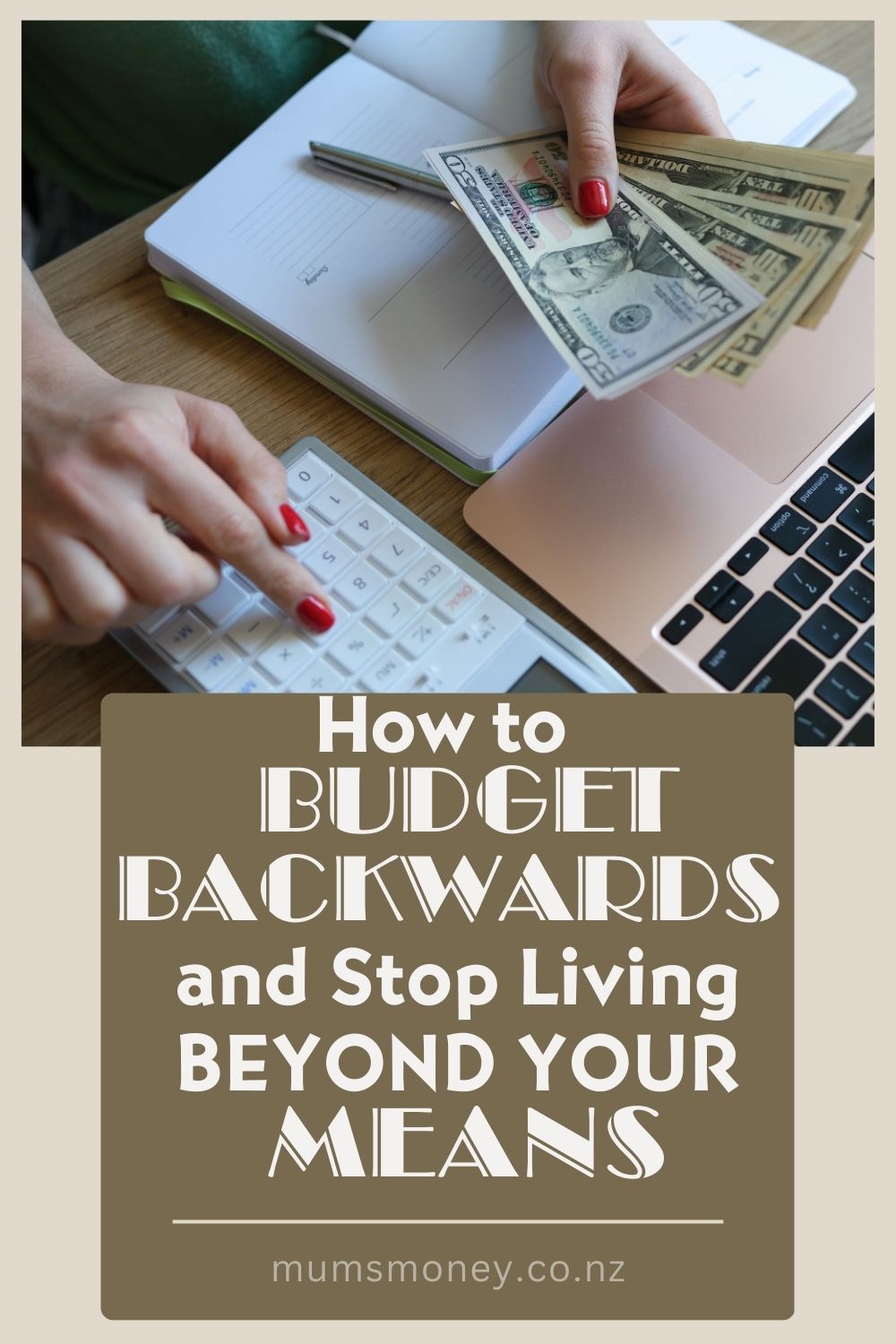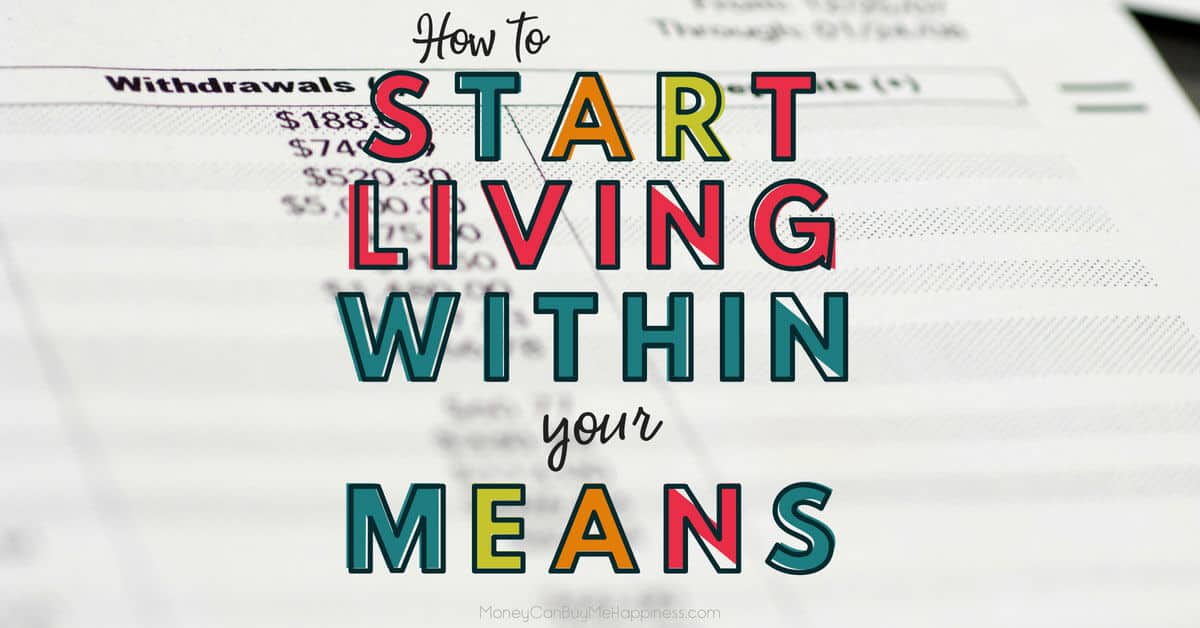
How do you know if you’re living beyond your means?
It might go something like this: You have a job.
Pay rent.
Have a car.
You didn’t have the cash for the car so you got a car loan.
Each week or month you commit a large chunk of money to maintain a depreciating asset.
You go shopping, eat out whenever you like, live your life.
You put your vacation on a credit card.
Eventually, you have no credit available, the credit card is maxed and you start to panic.
You are up sh*t creek. There is no paddle.
This is living beyond your means. I’ve been there.
If you are like me the panic is accompanied by the painful awareness that you have no idea how to change your situation. You consult Dr Google.
You will start to read everything you can about money management (start with this book, ‘‘The Simple Path to Wealth: it’s the one I wish I’d read ten years ago).
You will be terrified.
There will be a period of intense disappointment when you realise how different things could have been.
You cannot change the past, so you resolve to alter the future.
You find a strong stick and drag your way out of that quagmire of a creek, eyes cast towards your feet in shame.
I know this story well because it is mine.
Like many people who blog about money, I hit bottom before I learned how to manage finances.
And yet, my husband and I have recently celebrated one year of travel.
From New Zealand to the USA to Mexico and Europe. A Mediterranean cruise. Disney World. All paid for with savings. No debt at all.
It’s been epic.
And once upon a time, I was just like you, spending more than I earned and stressing about money.
Let me tell you how I turned my finances around.

How I Started to Live Within My Means
Living within your means is achievable for everyone.
For me, I had to ignore my income and focus on my expenses.
I drew up a budget that accounted for everything we needed, regardless of how much we earned.
I was aware of our income limitations, of course, but they did not dictate how I budgeted.
The figure changed slightly to account for increases in expenses as I went from living in a shared house with roommates to living in a one-bedroom apartment and then to living in my own house with my family.
You see, the problem with budgeting the other way round – by working out what you earn and then how to divvy it up to cover what you need/want – means you’ll never have a spare dollar.
I promise you every gap will be filled.
If you are a master budgeter you might plan savings as part of your budget but the reality is that most people don’t pay themselves first.
They pay the bills and then what’s left has to cover everything else.
There might be a little left over for savings, but more than likely, that little bit will go on crap you don’t need.
Our first year as parents was a financial shock to the system.
We were used to earning two full-time incomes, which allowed us to save over 50% of our combined income.
The system of budgeting I describe below is the only thing that kept us afloat (and has done ever since).
Side note: I believe living on one income and saving the other is the number one way for couples to save – especially in the years leading up to starting a family.
Years of living on one income and pretending like the other didn’t exist is the whole reason I was able to ignore my means when drawing up my first family budget.
A Look At My Fixed Living Costs (FLC)
And also a massive disclaimer because I’ve been getting some snarky comments and emails implying that I suggest you should mimic my expenses – OF COURSE NOT, that is ridiculous.
I am only sharing my budget to illustrate how we put this system in place.
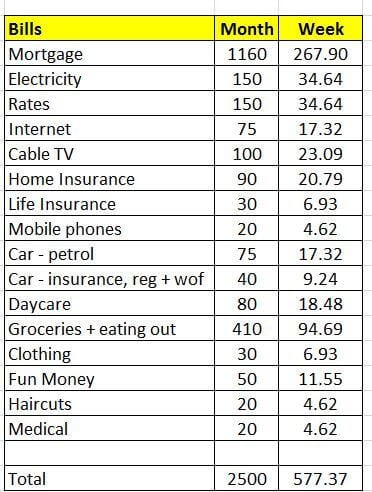
I’m not talking about just surviving here.
This site is called Money Can Buy Me Happiness – not Having No Money Makes Me Hate My Life.
Your FLC should include everything you need to stay alive and ahead of your creditors and a small allowance you can blow however you want.
For example, the budget I drew up gave us a little fun money ($25 each per month) and covered all the significant expenses (mortgage, insurance, groceries, electricity etc).
The most recent amount – pre-travel – that I could whittle my FLC down to was $2500 per month or $30,000 per year.
That included mortgage payments, insurance, taxes, rates, electricity, internet, cable TV, groceries, daycare, all car-related expenses, clothes, medical, and fun money. Everything.
On the first of every month, $2500 was transferred from the mortgage offset account into the ‘Bills’ account, and we lived as if $2500 was all we had.
Every wage or salary payment was made directly to our mortgage offset account.
Depending on where you live, $2500 may or may not be a lot of money. Where I live, it’s not a lot of money.
Our house expenses accounted for just over half of that and we were very careful with the remainder.
Our home is in a city with many wonderful parks and woodlands to explore for free so we made the most of low-cost activities.
I also bought a cheap home espresso machine so I could make proper coffee at home.
That single act saved us thousands.
Our income during this period varied from $3500 per month to $5000.
As one of us was always a stay-at-home parent, our ability to increase earnings was limited, but the important thing is our expenses never varied.
On a bad month, we saved $1000 and on a good month, it could be $2500.
Without fail, the savings account was growing. The only thing that varied was the speed of the growth.

How To Budget Around Your Core Expenses
If you are interested in budgeting around your core expenses instead of letting your income dictate what you spend, here’s how I do it.
1. Work out what you actually need to live each month
Here’s where you’ll need to sit down with a pen and paper and open your bank statements or online banking.
For now, ignore your income.
What you need is a list of your core expenses.
For most, that’s mortgage/rent, insurance, utilities, food, transport costs, debt repayments, memberships, subscriptions, and gifts.
I also recommend setting aside an amount as fun money or blow money or whatever you want to call it.
Restrictive budgets that don’t account for the fun things in life fail (they are similar to diets in that sense).
Look at your bank statements for an accurate picture of where you spend your money.
Add together all those categories into a monthly sum you require to live.
Now you need to look at your income to ensure you’re earning more than you need to spend.
Note: If your monthly figure is more than you earn, you need to go back to the drawing board.
This budget relies heavily on consciously living within your means, so you’ll need to cut costs in order to get your monthly expenses lower than your income amount.
2. Get a month ahead
This is probably the most challenging step but it’s the most important.
The only way my budget continues to work is because I am able to pay for next month’s living costs using money earned this month.
We do not live hand to mouth anymore.
In order to get one month ahead on your budget you need to carefully calculate exactly what you need to spend each month, and then allow an extra buffer.
I figured we’d need $2500 per month in order to pay all of our bills and feed the kids well.
We had that amount in savings but if you don’t have savings, I recommend checking out this post to get you started with your monthly nut.

3. Budget monthly, regardless of pay frequency
On the first day of our monthly budget, I get online and transfer the amount of $2500 from our ‘Savings’ account to our ‘Bills’ account.
I need to have separate bank accounts for this system to work.
I then pay all the essentials – transferring the monthly amount to the mortgage, a monthly grocery allowance to the everyday account, and keeping what’s left over in the Bills account for direct debits.
4. Accumulate funds in a separate account
All the wages and extras – my business income and tax credits – accumulate in the ‘Savings’ account.
I leave them there until we hit our monthly sum of $2500.
Sometimes that will take four pay weeks; sometimes, it takes 3.
We’ve had some cracking bonus weeks’ where we’ve hit our living costs for next month in 2 weeks.
I love those months, but they’re not the norm.
The next step is the same regardless of how long it takes to hit $2500.
I gleefully transfer the excess into our travel savings account.
For now, that is our main focus, so we save towards that each month.
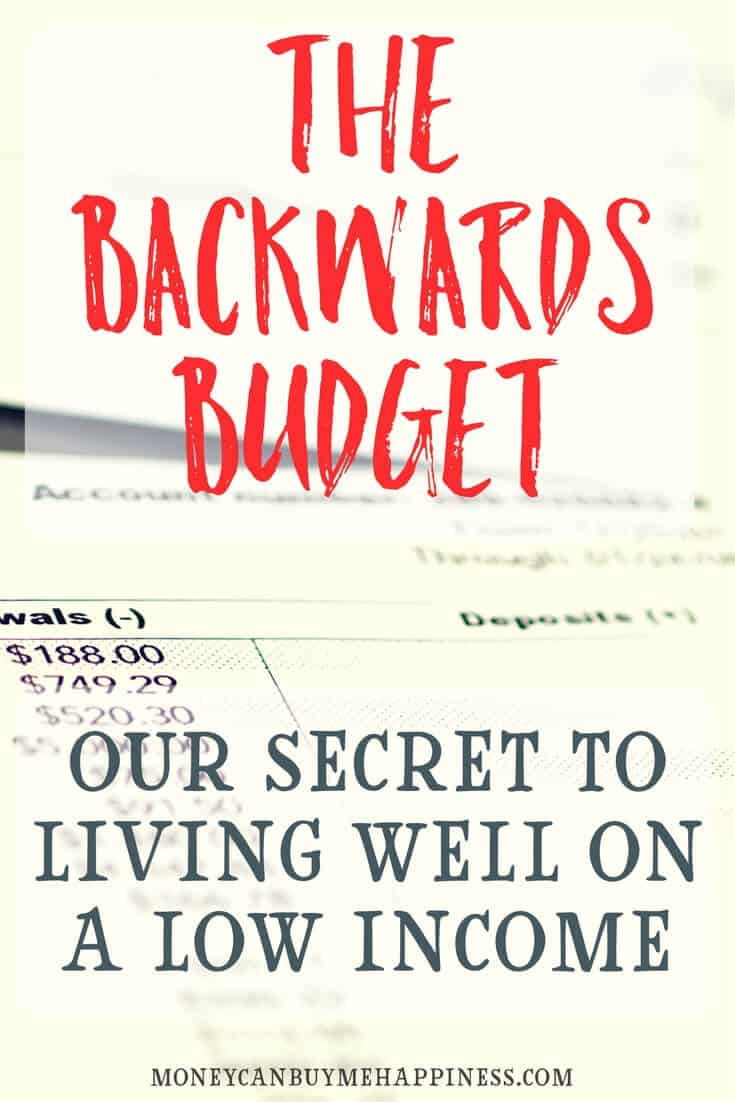
5. Live as if the monthly sum you’ve budgeted is all you have
This is perhaps the most testing step; you must live as if you only have your monthly allowance.
In the beginning, I struggled with this as I knew I had more money in a different account, but now it’s become second nature to only spend the set amounts in each budget category.
Having a large lump sum for my groceries each month is especially helpful, as it allows me to stock up on bulk buys or clearance deals when I see them.
6. Review and amend
At the end of each month, I review our spending to make sure we haven’t overspent.
I also review whether we’ve given ourselves enough to live on comfortably.
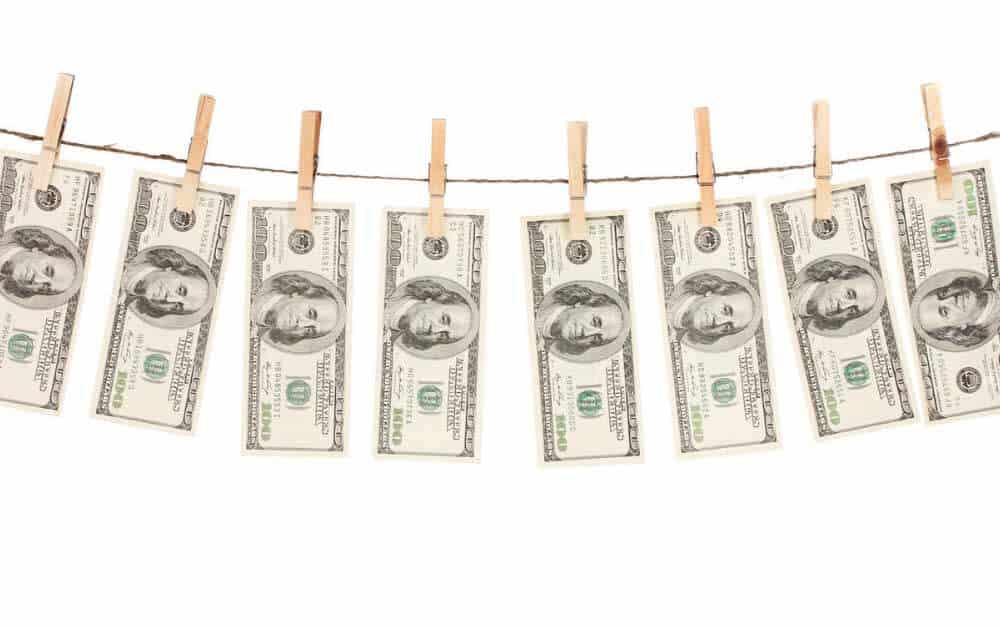
6 Reasons It’s Smart To Live on a Fixed Amount
1. You always know what you’ve got available.
The amount never changes.
You will adapt and become an ace at keeping spending in that category within the correct range.
Living frugally becomes second nature.
2. The temptation of lifestyle inflation is eliminated.
All of your salary increases, tax refunds and other extras hit the bank account and have no impact on your spending.
Your spending stays the same whether you earn 50k or 100k.
3. It’s easy to ascertain the amount you’ll need to retire early or travel the world for a year.
4. If you ever need social assistance due to job loss, you are already used to spending small.
You will adapt faster than someone who has been living week to week.
5. You will be filled with that warm fuzzy feeling that you are building wealth. It will help with the challenging times.
6. Any extra money you make on top of your regular income goes directly towards things like debt repayment, building a savings buffer or travel fund.
The extra money might come from an online side hustle like starting an online business or taking online surveys.
So What Does My Fixed Living Cost Life Look Like?
One 23-year-old car
Paid for with cash. It cost $1000.
The front electric windows are stuffed, so we try to avoid driving in the heat of the day in summer.
Other than that, it’s a fabulous car, and we will drive it into the ground.
Cycling to work
When I was the primary earner, I cycled to my office in the central city (an easy 12-minute ride, door-to-door) as often as possible.
It helped us keep our fuel spending under $100 per month.
Shopping around for the best deals.
If that means scouring websites for the best deal, then so be it.
I also run everything I buy online through Rakuten to see if cashback is available before I complete my purchase.
If you’re interested in Rakuten (and you should be – it’s getting back the money you were going to spend anyway), you can join for free.
Use this link to join Rakuten today and you’ll get $10 towards your first eligible purchase of $25 or more.
Haircuts at the local hairdressing academy
A full head of highlights, a cut and blow dry, costs $30.
It takes over 3 hours, but I save over $80 compared to a full salon service, and the quality is the same as all trainees are overseen by a qualified tutor.
That’s an after-tax hourly rate of over $26 for sitting down and reading magazines. Not a bad day’s work.
A starter home.
Currently, an earthquake-damaged starter home. Three bedrooms, big garden.
Close to the central city. Bought with a 90% mortgage in 2011.
Hand-me-down clothes
For my sons and minimal clothing purchases for my husband and I.
A weekly takeaway dinner of fish and chips.
Sometimes Thai or Pizza. But 85% of meals are cooked at home.
A vegetable garden in the backyard
Which produces herbs, lemons, potatoes, lettuce, plums, and courgettes (zucchini).
Plus a weekly $10 subscription (now $12) to our local co-op for two large shopping bags of seasonal fruit and vegetables.

Free activities
Not hard in a city of beautiful parks with a toddler that likes to spend time looking at sticks, rocks and ants.
Kids certainly help you appreciate the simple things in life.
No health insurance.
This is quite common in New Zealand. We currently receive free medical care and prescription medicine for all children under 13.
Sometimes I took my newborn son to the doctor twice per week just to be sure.
General Practitioner visits for adults are around $40 per visit so we pay out-of-pocket.
Prescription medicine is capped at $5 per item for adults.
We probably spent around $150 on medical care for the year.
After travelling the world and seeing what healthcare costs in other countries, I am super-grateful to be a citizen of New Zealand.
Our system is not perfect, but it’s a lot better than most.
Prepaid phones.
We love to travel long-term. Phone contracts are anathema to the mobile lifestyle. Enough said.
The Importance of Having Goals
Living this way has now become the norm.
Being able to travel extensively with my family is worth every sacrifice.
As I put together a plan to chase the summer around the world, my budget will tighten, and I’ll have to find ways to reduce my FLC even further.
Without this huge, crazy dream I’m sure I wouldn’t be motivated to cut costs and keep such a close eye on things.
You need a big hairy goal to keep motivated when things get tough, so work out what that is and get started making it a reality.
I firmly believe we are capable of anything we put our minds to. But we must put our minds to something.
Whether it’s paying off debt, travelling, starting a family or raising a deposit for your first house – there must be a motivating factor.
Frugality for frugality’s sake, would be hard to maintain.
The knowledge that I am living well within my means and the desire to achieve my goals gets me through tough times.
Note: to build a more balanced site about personal finance, I’ve started to explore new budgeting methods.
I still budget the way I talk about in this post, but it might not be suitable for you, and I get that.
Another budgeting strategy that works for many people is the zero-sum budget.
Check out this post to learn more about it: The Ultimate Beginners Guide to Zero-Sum Budgeting.
There’s also the 50/30/20 Budget. Remember, the best budgeting strategy is the one you can stick to!
Related guides:
